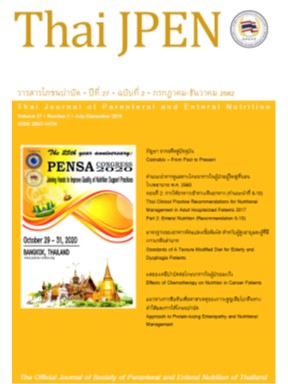มาตรฐานของอาหารดัดแปลงเนื้อสัมผัส สำหรับผู้สูงอายุและผู้ที่มีภาวะกลืนลำบาก
คำสำคัญ:
อาหารดัดแปลงเนื้อสัมผัส, ผู้สูงอายุ, ภาวะกลืนลำบากบทคัดย่อ
ภาวะกลืนลำบาก สามารถเกิดขึ้นได้ตลอดกระบวนการกลืน ตั้งแต่ช่องปาก คอหอย และหลอดอาหาร อันเนื่องมาจากการเปลี่ยนแปลงทางสรีรวิทยาที่เกี่ยวข้องกับการกลืนในผู้สูงอายุ ทำให้ความสามารถในการกลืนเสื่อมถอยลง และอาจมาจากภาวะอื่น ๆ เช่น ความผิดปกติด้านระบบประสาท โรคมะเร็งส่วนศีรษะและลำคอ เป็นต้น เมื่อผู้ป่วยได้รับการวินิฉัยว่ามีภาวะกลืนลำบากแล้ว ทีมสหสาขาวิชาชีพจำเป็นต้องให้การดูแลรักษาอย่างเร็วที่สุดเพื่อป้องกันภาวะแทรกซ้อนอื่น ๆ เช่น อาการสำลัก ปอดอักเสบ ภาวะทุพโภชนาการ ภาวะขาดน้ำ เป็นต้น หากประเมินแล้วผู้ป่วยไม่สามารถกลืนได้อย่างปลอดภัย ควรพิจารณาให้อาหารทางสายให้อาหารหรืออาหารผ่านทางหลอดเลือดดำเป็นลำดับต่อไป แต่หากทำการประเมินแล้วผู้ป่วยสามารถฝึกกลืนได้ ควรวางแผนโภชนบำบัดโดยใช้การปรับเนื้อสัมผัสอาหารให้เหมาะสมกับความสามารถในการกลืน การฟื้นฟูทักษะการกลืน และเพื่อให้มีภาวะโภชนาการที่ดี บทความนี้ จึงได้รวบรวมมาตรฐานของอาหารดัดแปลงเนื้อสัมผัสจาก 3 ประเทศ ได้แก่ ประเทศสหรัฐอเมริกา ประเทศออสเตรเลีย และประเทศญี่ปุ่น และมาตรฐานอาหารสำหรับผู้ที่มีภาวะกลืนลำบากที่เกิดจากองค์กรความร่วมมือนานาชาติของสหสาขาวิชาชีพ (International Dysphagia Diet Standardisation Initiative: IDDSI) ได้สรุปถึงคำศัพท์ คำอธิบาย ตัวอย่าง และวิธีการทดสอบตามเกณฑ์ของแต่ละมาตรฐาน เพื่ออำนวยความสะดวกต่อการนำไปประยุกต์ใช้ในงานโภชนาการในการดูแลผู้ป่วยกลุ่มนี้ต่อไป
เอกสารอ้างอิง
ปิยะภัทร เดชพระธรรม. ปัญหาการกลืนในผู้สูงอายุ (Dysphagia in Elderly): เวชศาสตร์ฟื้นฟูสาร. 2556;3:73-80.
สร้างเสริมสุขภาพช่องปากผู้สูงอายุ [ออนไลน์] [เข้าถึงเมื่อ 5 กันยายน 2562]. เข้าถึงได้จาก: https://www.thaihealth.or.th
สำนักทันตสาธารณสุข.รายงานผลการสำรวจสภวะสุขภาพช่องปากแห่งชาติ ครั้งที่ 8 ประเทศไทย พ.ศ. 2560. ในกลุ่มวัยสูงอายุ 60-74 และ 80-85 ปี, หน้า 17.กรุงเทพมหานคร : สามเจริญพาณิชย์. 2561
ศศุภางค์ มุสิกบุญเลิศ. การรักษาผู้ป่วยกลืนลำบาก. ศรีนครินทร์เวชสาร 2014;29
Clayton J, editor. The National Dysphagia Diet: standardization for optimal care. Chicago, IL: Amercian Dietetic Association. 2002
คณะกรรมการผู้สูงอายุแห่งชาติ.สถานการณ์ประชากรในปี 2560. สถานการณ์ผู้สูงอายุไทย พ.ศ.2560. 2561;1:3-14.
Jeffrey C.Posnick. 8 - Speech, Mastication, and Swallowing Considerations in the Evaluation and Treatment of Dentofacial Deformities. Orthognathic Surgery. 2014;227-63.
Palmer JB, Monahan DM, Matsuo K. Rehabilitation of patients with swallowing disorders. In Braddom RL editor. Physical Medicine & Rehabilitation. 3rd edition China: Saunders Elsevier. 2007;597-616.
Puisieux F, D’Andrea C, Baconnier P, Bui-Dinh D, CastaingsPelet S, Crestani B, et al. Swallowing disorders, pneumonia and respiratory tract infectious disease in the elderly. Rev Mal Respir. 2011;28(8): e76-93.
Ono T, et al. Influence of bite force and tongue pressure on oro-pharyngeal residue in the elderly. Gerodontology. 2007; 24(3):143-50.
Ney D, Weiss J, Kind A, Robbins J. Senescent swallowing: impact, strategies and intervention. Nutr Clin Pract. 2009; 24(3): 395-413.
Cichero JAY. Adjustment of Food Textural Properties for Elderly Patients. Journal of Texture Studies. 2016;47(4):277-83.
Atherton M, et al. Texture-modified foods and thickened fluids as used for individuals with dysphagia: Australian standardisedlabels and definitions. Nutrition & Dietetics. 2007;64 (Suppl. 2): S53–S76
Debbie Z. Making Dysphagia Easier to Swallow. The National Dysphagia Diet is 10 years old this year. 2012: 1-4.
Gary McCullough,Cathy Pelletier,Catriona Steele. National Dysphagia Diet: What to Swallow?: The ASHA LEADER. 2003; 20(8):16-27.
Efforts Relating to "Smile Care Food" [Online] [Cited 2019, May 30th]. Available from: http://www.maff.go.jp/e/policies/food_ind/attach/pdf/index-9.pdf
มาตรฐานการผลิตสมัครใจ (Universal Design Food) [ออนไลน์] [เข้าถึงเมื่อ 15 กรกฎาคม 2562]. เข้าถึงได้จาก: http://www.oie.go.th/sites/default/files/attachments/article/foodaging society.pdf
Dietitians Association of Australia, & Speech Pathology Association of Australia Limited. Texture‐modified foods and thickened fluids as used for individuals with dysphagia: Australian standardised labels and definitions. Nutrition & dietetics. 2007; 64, S53-S76.
Cichero, J. A., Lam, P., Steele, C. M., Hanson, B., et al. Development of international terminology and definitions for texture-modified foods and thickened fluids used in dysphagia management: the IDDSI framework. Dysphagia. 2017; 32(2), 293-314.
มาตรฐานอาหารสำหรับผู้ป่วยกลืนลำบากวิธีการทดสอบ [ออนไลน์] [เข้าถึงเมื่อ 10 กรกฎาคม 2562]. เข้าถึงได้จาก: http://iddsi.org/translations/
Transitional Foods as Potential Dysphagia Treatments [Online] [Cited 2019, May 30th]. Available from: https://www.swallowstudy.com/cotton-candy-therapy-transitional-foods-dysphagia-treatment/
ดาวน์โหลด
เผยแพร่แล้ว
รูปแบบการอ้างอิง
ฉบับ
ประเภทบทความ
สัญญาอนุญาต
เนื้อหาและข้อมูลในบทความที่ตีพิมพ์ลงใน Thai JPEN วารสารโภชนบำบัด ถือเป็นข้อคิดเห็นและความรับผิดชอบของผู้เขียนบทความโดยตรงซึ่งกองบรรณาธิการวารสารไม่จำเป็นต้องเห็นด้วยหรือร่วมรับผิดชอบใด ๆ
บทความ ข้อมูล เนื้อหา รูปภาพ ฯลฯ ที่ได้รับการตีพิมพ์ใน Thai JPEN วารสารโภชนบำบัด ถือเป็นลิขสิทธิ์ของ Thai JPEN วารสารโภชนบำบัด หากบุคคลหรืหน่วยงานใดต้องการนำทั้งหมดหรือส่วนใดส่วนหนึ่งไปเผยแพร่หรือเพื่อกระทำการใด จะต้องได้รับอนุญาตเป็นลายลักษณ์อักษรจาก Thai JPEN วารสารโภชนบำบัด ก่อนเท่านั้น



